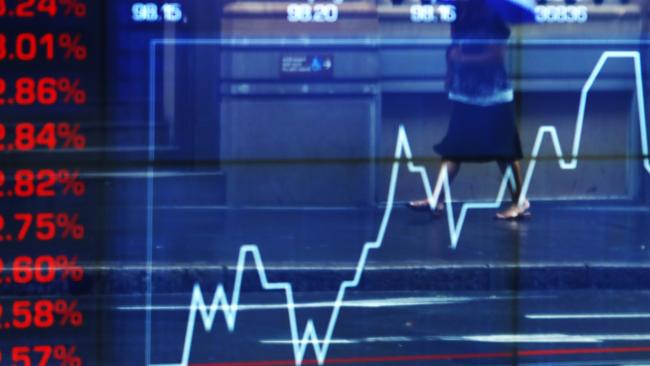Better to err on the side of caution as record subsidies boost exuberance and complacency

The equity risk premium refers to the return in excess of the risk-free rate of return (government bonds) an investment in shares is expected to yield. Against bonds, shares — even at these levels — look undervalued.
In contrast, yields are at all-time lows. I suggest they will be staying low for years to come, making shares as an asset class relatively attractive.
Moreover, in the absence of inflation, I argue we may even see yields go lower, though from this point onwards this is now a marginal game. On this basis, you may say bond yields are underpinning equity valuations.
As we enter reporting season for the second quarter in the US and the first half in Australia, we all know the numbers will be ugly.
In the next few days we are going to see results for Commonwealth Bank, Seek, Woodside, AMP and many others.
Keep in mind that this season it is not about what is reported and consensus earnings forecasts. Instead, it will be about how companies see the outlook and the recovery they express.
It is about whether they provide guidance when, globally, forward guidance universally has been pulled. Transparency on earnings is crucial, and how they hold up at this stage is down to central bank stimulus.
I will be watching reporting season closely to observe how corporations focus on the outlook.
Crucially, I will look for earnings recovery figures against pre-COVID-19 levels.
What markets will be looking for is whether recovery is next year or 2022, as markets have already factored in a general recovery for next year.
Given COVID-19 impacts, this is a vital theme for discussion and is relevant in the light of Australia’s recession economy.
Globally, we’re seeing the worst conditions since the Depression, on the one hand, and the strongest equity rally in the US (S&P 500) since 2009 on the other. Essentially, markets are going through a “melt-up” such as we experienced in 1999. The melt-up is focused most strongly towards technology stocks, with lagging sectors dragged up with the rest of the market.
Several weeks ago economists were arguing about the shape of the recovery. Was it V, U or L shaped? Meanwhile, market commentators are asking “Have investors lost their minds?”, as the gap between Wall Street and Main Street persists.
The role of the central banks, including Australia’s Reserve Bank, is important to consider. Look to the extent of issuance in fixed-income securities, as central bank demand from institutions such as the Federal Reserve in the US has pumped liquidity into the bond markets.
Credit markets as well as equities have been elevated, with asset prices based on more than $US10 trillion ($13.9 trillion) in stimulus globally.
JPMorgan’s chief executive recently described the trend as “like water filling cracks”.
I have often said: “Don’t fight the Fed.” This time is no different given the record levels of stimulus, not only in the US and Australia but also globally by central banks.
The total aggregate numbers are reported as being between $US10 trillion and $US11 trillion. Whatever the actual figure, it is huge, and anywhere between 2½ and three times that seen during the global financial crisis a decade ago.
Leading independent economics research house Capital Economics sees equity price recovery as being down to economic recovery. This argument is based around making up ground from the lockdowns, combined with the accommodative monetary policies pursued by central banks.
The British-based group also notes equity valuations have risen sharply with the forward price-earnings ratio near its highest levels since the 2001 dotcom bubble.
The MSCI US index now accounts for more than 65 per cent of the MSCI World Index. In turn the US market has been led by the largest technology-related stocks.
Some economists remain optimistic about the outlook for equities and other risk-based assets. Others are more cautious, warning that any rapid increase in COVID-19 cases such as the US is experiencing poses a key downside risk to our generally optimistic forecasts.
What does all this mean for Australian investors? We must err on the side of caution. Remember that insolvency numbers are down 40 per cent from long-term averages, propped up by government subsidies. Directors have a temporary relief in legal obligations regarding a company’s solvency, yet debts are on the rise.
At the same time, forward orders in construction, the largest contributor to small and medium-size enterprise revenues, is down by at least 25 per cent. Yet we are willing to pay 19 times forward earnings for Australian equities.
The extent of stimulus has created what can be described only as exuberance. Complacency is at work yet again and, given the effects on Main Street referenced above, cannot be justified.
As Providence Wealth chief executive Grant Patterson said to me this month: “Maybe it’s different this time but the result will be the same.”
Will Hamilton is the managing partner of Hamilton Wealth Partners, a Melbourne-based wealth manager.






Too expensive or too cheap? Whatever your position, right now sharemarket valuations are creating quite a debate.